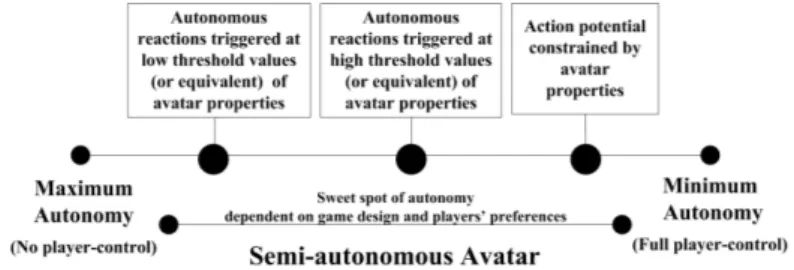Semi-Autonomous Avatars in Games
Mirjam P EladhariGotland University, Department of Game Design, Technology and Learning, Cramergatan 3, 62157 Visby, Sweden
mirjam.eladhari@hgo.se
Semi-autonomous avatars are agents whose actions are controlled partly by users and partly by artificial intelligence (AI) components. Virtual game worlds (VGWs) are realised by networked computers that simulate persistent virtual environments which allow large numbers of users to act in the worlds simulta-neously, represented by avatars (playable characters). What players can do in a given moment is determined by the action potential of their avatars, which in turn is determined by the game design of particular VGWs. Avatar-specific properties can be used in the design to represent the world in individual ways for different players. The same data can be used to automate avatar behaviours, such as reaction tendencies or subtle body language. In VGWs it is desirable that not only the autonomous agents, or non-player characters (NPCs) are be-lievable in Bates’ [1] sense, but also that the avatars are bebe-lievable for players, both when they control their own avatar and when they interact with others’ avatars. In VGWs player may use methods from role-playing [3] in order to ‘stay in character’, that is, to act in ways that are consistent with the nature of their avatars. Motivations and design goals for developing semi-autonomous agents are unique to particular projects, but can be categorised into three main groups of purpose, relief, expression and impression, as described in the following list.
1. Relief. Aim to relieve users of cognitive or operational load. In navigational systems the aim is to let the AI perform navigational tasks at a micro-level [6]. In virtual environments AI components are often used to continuously choose and execute animations showing body language of the users’ rep-resentations, such as gestures, facial expressions, postures, or gaze. This is especially motivated in systems where user interfaces makes it difficult for users to control multi modal expressions with the available input devices. 2. Expression. Aim to increase the believability of the agents to players
observ-ing them or interactobserv-ing with them. In graphical environments where users take on a virtual human form, subtle body-language, which in everyday life is performed unconsciously, can give impressions of lifelikeness of avatars. Per-sonalised reaction tendencies of agents can be helpful for characterisation, aiding in making virtual games and environments more interesting. The ac-tion potential of an agent is what it can do at a given moment with it all the circumstances inherent in the context taken into account. Personalised action potential of avatars in role-playing worlds can help players to ‘stay in character’, increasing the sense of presence or immersion in the fictional game world for its inhabitants [2]. Other powerful ways of providing players
2 Eladhari
with means of expression is to support players’ creation of objects and of individual behaviour patterns, such as own sequences of animations. 3. Impression. Aim to characterise avatars to their players and/or to provide
individual representations of particular game worlds. Character-information available only to avatars’ own players shows the action potential of the avatars - what they can do at a given moment and how. The properties of avatars can be used to represent the game world subjectively, helping play-ers to identify with their representations and immplay-erse themselves into story worlds. For example, in Subjective Avatars [5] users receive text descriptions of environments which reflect avatars emotional states.
A well known rule of thumb in game design is to make sure that the players feel in control [4]. Autonomous behaviour of avatars is rare in VGWs while the restraining of action potential of avatars is inherent in all designs. The degree of player-control which would result in enjoyable game play for players, the sweet spot of semi-autonomy, could vary with the specific design of a VGW on a sliding scale of control as illustrated in Figure 1.
Fig. 1. Semi-autonomy
References
1. J. Bates. The role of emotions in believable agents. Technical Report CMU-CS-94-136, Carnegie Mellon University, PA, USA, 1994.
2. M. P. Eladhari and M. Mateas. Rules for role play in virtual game worlds - case study: The pataphysic institute. In Digital Arts and Culture, Los Angeles, USA, December 2009. University of California Irvine.
3. G. A. Fine. Shared Fantasy - Role-Playing Games as Social Worlds. The University of Chicago Press, 1983.
4. J. H¨oysniemi, P. H¨am¨al¨ainen, and L. Turkki. Wizard of oz prototyping of computer vision based action games for children. In Proceedings of IDC 2004, College Park, Maryland, USA, 2004.
5. M. Mateas. Subjective avatars. In AGENTS ’98, pages 461–462, New York, NY, USA, 1998. ACM.
6. D. Miller. Semi-autonomous mobility versus semi-mobile autonomy. In AAAI Spring Symp., Stanford, CA, 1999.
